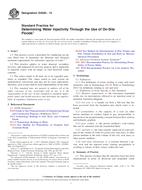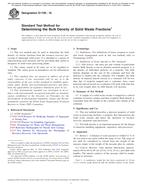1.1 This test method covers the capillary gas chromatographic determination of various organochlorine pesticides, including some of their degradation products and related compounds in finished drinking water. This test method is not limited to this particular aqueous matrix; however, its applicability to other aqueous matrices must be determined. The tested compounds include the following:
| Pesticide | Chemical Abstract Service Registry Number |
| Aldrin | 309-00-2 |
| -BHC | 319-84-6 |
| -BHC | 319-85-7 |
| -BHC | 319-86-8 |
| -BHC | 58-89-9 |
| -Chlordane | 5103-71-9 |
| -Chlordane | 5103-74-2 |
| Chlorobenzilate | 501-15-6 |
| Chloroneb | 2675-77-6 |
| Chlorothalonil | 2921-88-2 |
| DCPA | 1897-45-6 |
| 4,4`-DDD | 72-54-8 |
| 4,4`-DDE | 72-55-9 |
| 4,4`-DDT | 50-29-3 |
| Dieldrin | 60-57-1 |
| Endosulfan I | 959-98-8 |
| Endosulfan II | 33213-65-9 |
| Endosulfan sulfate | 1031-0708 |
| Endrin | 72-20-8 |
| Endrin aldehyde | 7421-93-4 |
| Etridiazole | 2593-15-9 |
| Heptachlor | 76-44-8 |
| Heptachlor epoxide | 1024-57-3 |
| Hexachlorobenzene | 118-74-1 |
| Methoxychlor | 72-43-5 |
| cis-Permethrin | 52645-53-1 |
| trans-Permethrin | 52645-53-1 |
| Propachlor | 1918-16-7 |
| Trifluralin | 1582-09-8 |
1.2 and list the applicable concentration ranges and precision and bias statements for this test method. The applicability of this test method to other compounds must be demonstrated.
1.3 The extract derived from this procedure may be analyzed for these constituents by using the gas chromatography (GC) conditions prescribed in Test Method D 5175 (capillary column). Although the columns used in this test method may be adequate for analyzing PCBs, no data were collected for any multi-congener constituents during methods development.
1.4 This test method is restricted to use by or under the supervision of analysts experienced in the use of GC and interpretation of gas chromatograms. Each analyst must demonstrate the ability to generate acceptable results using the procedures described in Section 12.
1.5 Analytes that are not separated chromatographically by either the primary or secondary chromatographic columns (for example, analytes having very similar retention times) cannot be identified and measured individually in the same calibration mixture or water sample unless an alternative technique for identification and quantitation exists (see 7.9 and 13.4).
1.6 When this test method is used to analyze unfamiliar samples for any or all of the analytes listed in 1.1, analyte identifications and concentrations should be confirmed by at least one additional technique.
1.7 The values stated in SI units are to be regarded as the standard.
1.8 This standard does not purport to address all of the safety concerns, if any, associated with its use. It is the responsibility of the user of this standard to establish appropriate safety and health practices and determine the applicability of regulatory limitations prior to use. Specific hazards statements are given in Section 9.
Product Details
- Published:
- 01/01/2002
- Number of Pages:
- 12
- File Size:
- 1 file , 130 KB


